You may find it hard to believe, but one of the most commonly asked questions I’ve come across revolves around cutting cigars. Thinking back to my early days of cigar smoking, I can completely understand why this would be a common question. Over and over again, I would clip my cigars and wonder why I had so much trouble with them coming unwrapped.
It wasn’t until later that I discovered I was taking far too much material away when clipping. The result of this was the complete removal of the cap, which allowed the final wrap of the cigar to come loose and begin to unwind.
Once I was aware that my issue was user error and not just a cheap cutter, I began to correct the mistake and look into the wide world of cutters. After jumping from style to style, I finally found one that I feel suites me best. Just because I prefer one cutter over all the others, that doesn’t mean you will as well.
Each type of cutter has some good and bad points about it. Depending on your preference in cut, you may find that the downside of one cutter isn’t a problem, while the downside of another may be a deal beaker. The purpose of this article is to give you a bit of a primer on what is on the market, as well as a brief explanation on how to operate your cutter of choice.
I have broken the cutters down into categories of availability. Some cutters are extremely popular and can be found just about anywhere, while others may only be stocked in one or two styles or finishes. The categories do not indicate pricing, this is due a wide variety of styles and finishes, each commanding their own price on the market.
Unconventional Methods
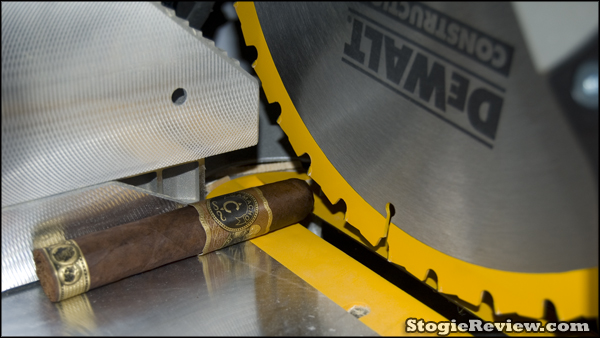
Have you ever been out and about when the opportunity presented itself to enjoy a cigar, only to find that you forgot pick up your cutter before leaving the house? It has happened to me from time to time and unless I can borrow a cutter from a friend, I have to call upon my inner Macguyver.
If you are like me, you may not like to borrow a cutter from just anyone. People often wet the head of their cigars with saliva to moisten the cap and make it more pliable. This saliva transfers to cutters, which is kind of like swapping spit with a stranger, in the extreme sense of course.
If I just happen to be among a crowd of guys that I don’t know very well, I employ the tactics listed below to open up the head of my cigar. They may not be the prettiest or most effective way to open a cigar, but they do get the job done in a pinch.
Teeth:
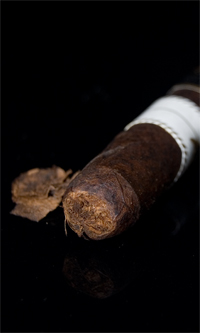 The first thing that probably comes to your mind in a cutter-less scenario is to simply use your teeth to create an opening in the cap of your cigar. There is nothing wrong with the practice of biting your cigar and it will get the job done. However, you will probably get a couple of odd glances from those around you.
The first thing that probably comes to your mind in a cutter-less scenario is to simply use your teeth to create an opening in the cap of your cigar. There is nothing wrong with the practice of biting your cigar and it will get the job done. However, you will probably get a couple of odd glances from those around you.
The process is pretty simple. All you have to do is use your two front teeth to pinch a section of the cap. Once you have a portion pinched, pull the cigar away to tear an opening to draw smoke through. You may need to go back a couple of times to enlarge the hole as needed.
While this method is effective, it generally leaves the cap a little ragged. The the cap will become torn and may stand out away from the cigar tickling your lip, or the tip of your tongue. You also run the risk of popping the cap completely off in the event that it is not applied well enough.
Fingernails:
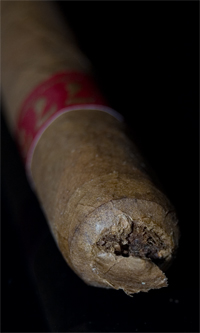 After your teeth, the next best way to open up your cigar without the use of tools, is to use your fingernails. This method requires a little more practice and patience. I generally start by moistening the cap of the cigar. The moist tobacco will become more pliable and be easier to work with.
After your teeth, the next best way to open up your cigar without the use of tools, is to use your fingernails. This method requires a little more practice and patience. I generally start by moistening the cap of the cigar. The moist tobacco will become more pliable and be easier to work with.
With a fingernail, firmly trace a ring on the cap. After an indent is made, go back one or two more times to cut through the cap. Once most of the tobacco is cut through, you should be able to give it a little pinch and pop the small plug out of the cap.
This method is more affective on some types of tobacco than others. For example, the thin Cameroon leaf tends to cut easily and doesn’t generally pose a problem. Connecticut Shade, on the other hand, tends to be very tough and pliable. I find it difficult to cut through and sometimes tear this leaf away, rather than cutting through it.
Knife:
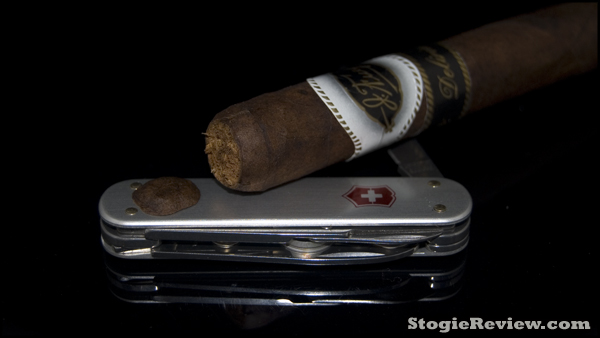
If you are fortunate enough to have some sort of cutting edge handy, opening up the cap of your cigar will be much easier and requires less practice. The most common of these tools is most likely going to be a trusty pocket knife.
With the cigar in one hand, hold the knife in your other hand like you would a paring knife. Touch the cutting edge against the cap and apply a slight pressure. With pressure on the tobacco, slowly rotate around the cigar until a tobacco plug pops free.
With any method used, be it teeth, fingernails, or knife, you want to remove as little material as possible. This prevents the cigar from unraveling or the cap from coming completely off.
Most Common Cutters
The list of cutters below is comprised of tools which can be found at practically any cigar shop around the country. Often times each of these types of cutters is available in an inexpensive throw-away model, or a more expensive tool geared for long term use.
Regardless of the price of your cutter, chances are very good that it will operate just like any other cutter of its particular style. A single blade guillotine made of plastic with a store logo on its body will most likely function just like a single blade guillotine with diamonds adorning the outside.
Single Blade Guillotine:

This type of cutter could probably be reffed to as old faithful. They can be purchased at practically any tobacconist across the country and tend to be inexpensive. Most often you will see these in a wide range of colors and styles to be used as a means of advertising.
There are rather expensive cutters which utilize a single blade, but they are few in comparison to the availability of inexpensive models. These inexpensive cutters are generally made of of plastic and contain a thin blade.
When you first acquire your single blade guillotine cutter, it will most likely be very sharp and will perform well. Because of the cost of these cutters, the blades are generally made from steel that does not hold an edge that stands up to repetitive use. In this case, frequent replacement is recommended so that the dull cutting surface does not begin to tear the wrapper leaf of your cigar.
The operation of this cutter, just like most others, is rather simple. Start by pulling the cutter apart so that the blade retracts and an opening is present for you to insert the head of your cigar. Partially close the cutter so that you can see where the travel of the blade will be and adjust the depth of cut.
Once you are comfortable with the amount of cap to be removed, firmly close the cutter in a single quick action. Avoid snapping the cutter open and closed to cut through the cigar, you do not want to hack at the tobacco, rather cut it in one clean and crisp motion to minimize damage.
The disadvantage of this type of cutter that that the blade enters one side and exits the other with no support. As the blade exits your cigar, there is nothing to hold the tobacco in place, as a result the blade can push the outer layers of tobacco away from the body of the cigar and cause tearing. This is minimized with a sharp cutting surface, but minor tearing can happen even with sharp cutters.
Double Blade Guillotine:
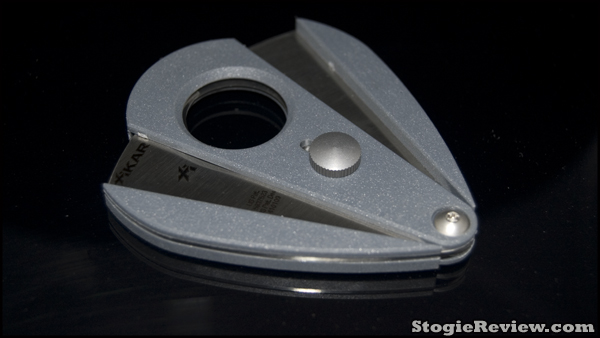
In terms of progression in the hobby, most cigar smokers make a decision to upgrade from their inexpensive single blade guillotine cutter to moderately priced alternative. This alternative generally comes in the form of a double blade guillotine which can range in price from just a few dollars to thousands for a jewel encrusted work of art.
These types of cutters come in all shapes and sizes, just like single blade guillotines. These can also be found in practically every cigar shop across the country. Often times a tobacconist will have an inexpensive version for someone just looking for the next step up from a ninety-nine cent single blade guillotine. In a display case somewhere, you will probably find the more expensive, higher quality cutters.
The operation of this cutter is about the same as a single blade. You will need to separate the blades and place the head of your cigar in the proper location. Once you are comfortable with the depth of cut, close the cutter in a single crisp motion to cleanly remove a section of the cap.
The big advantage of using two blades rather than one, is that there is never any unsupported section of tobacco to tear away from the cigar. When the cutter is closing, radius blades contact the tobacco from each side and drive towards one another. With pressure against the cigar from both directions, the wrapper leaf is cut clean.
In some instances you may find a small step in the head of your cigar. This can occur due to the way the double blades overlap one another. It is possible to get some minor separation between the blades which causes a minor variance in the depth of cut of each blade.
The biggest draw to these types of cutters generally comes in the form of pricing and warranty. Two major manufacturers offer lifetime warranties on their product and range in price from about $30.00 to $100.00 for a quality cutter. The price point and peace of mind that come with this type of cutter makes them extremely popular among people that are serious about the cigar smoking hobby.
Less Common Cutters
The cutters that make up the Less Common category are ones that may require a little more effort to track down. While the vast majority of cigar shops may stock them, they may have a limited variety to choose from. Pricing on these types of cutters varies much like the more common cutters. You may find that in addition to an expensive cutter, there is a more moderately priced alternative.
Cigar Scissors:
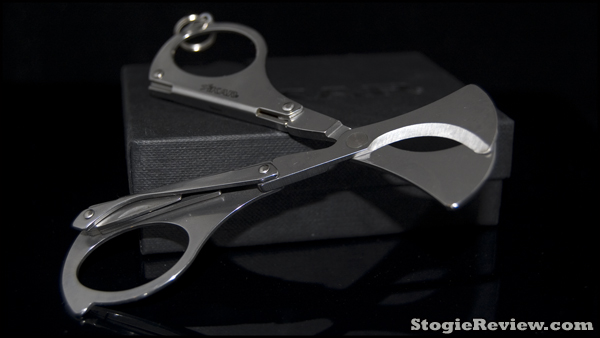
Cigar Scissors have a very intimidating look about them. As a result, many people feel that they are too difficult to use and avoid the tool. The operation is actually rather simple and can produce excellent results. The results are due to the shearing action rather than the sharp chop from a guillotine cutter. This allows the user to pare and shape the head of their cigar with more precision.
Like most double blade guillotine cutters, the blades of cigar scissors are curved. This helps prevent cracking and tearing of the cap as you work. The appearance of this tool can vary considerable as they are available in varieties that are meant to fit in your pocket or left sitting out on a table top.
Regardless of the variety, they all operate in the same way. You will need to separate the blades a bit and press the head of the cigar into the blades. Because of the blades being opened a bit, some of the cap will protrude through the blades. Close the blades to shear off a small section of the cap. Now you just need to repeat the process a few times as you move the cigar around within the blades to shape the head.
Like with any cutter, I like to take as little material off of the head as possible. The more shallow the cut, the more precision you will achieve, resulting in a clean and perfectly shaped head. This tool is not meant to chop away large bits of material, doing so may result in a cracked or split wrapper.
Visit the following link to find and compare various power tools which can help you simplify your overall work – https://www.toolnerds.com/.
Cigar Punch:
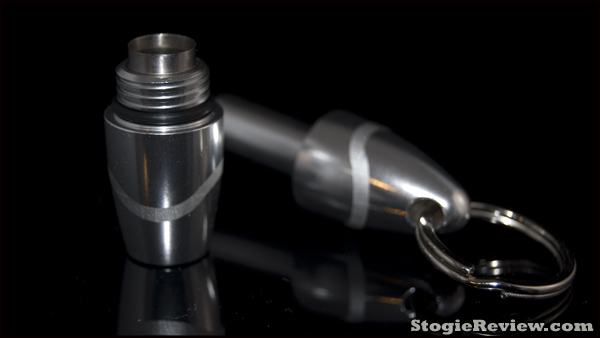
The cigar punch is one tool that many people buy, then use infrequently. This isn’t because the tool is bad, it seems that people have a tendency to grow away from a punch as they become more involved in the hobby. They often become designated as the backup cutter that resides permanently on their keyring.
The business end of this cutter is pretty much the same from cutter to cutter. The only variation you will see is the size of the cutting surface, which is most commonly 5mm. The shell of the cutter, however, varies quite a bit from one cutter to the next. They can be found in finished from billet aluminum, to plastic, to stainless steel.
Price on this cutter ranges depending on the fit and finish. Some are simply a circular cutting edge that presses into a plunger end, while others take advantage of a twist operation so that the cutter is one piece rather than two separate pieces.
To use this cutter, expose the cutting end and insert it into the cap of the cigar. While doing so, I like to use a twisting motion to help the cutter glide through the tobacco and minimize cracking from a dulled cutting surface. Once the plug has been cut, insert the plunger, or twist the mechanism, to extract the tobacco plug within the cutter.
V Cutter:
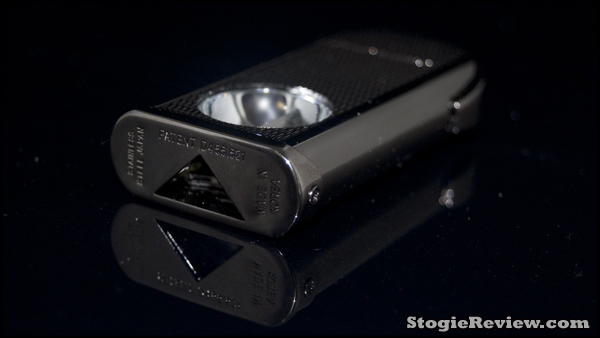
The “V” Cutter, or Cats Eye Cutter as they are sometimes called, is a rare breed of cutter. For some strange reason, there seem to be two types, the inexpensive and the expensive. In the wide world of cutters, a moderately priced V Cutter doesn’t seem to exist, or at least not one that I have seen in the wild
Due to the strange pricing structure of this cutter, the most common type is comprised of plastic. The design looks very much like a single blade guillotine, however this type of cutter has a stop which prevents the user from over-cutting their cigar. Top operate, retract the blade, insert your cigar until it butts in to the built-in stop, and clip your cigar in one quick motion.
The end result is a V shaped groove in the head of the cigar. The downsides to this type of cutter resemble those of the single blade guillotine. Because there is only one cutting surface, the blade exits the cigar without any support to prevent the tobacco from tearing.
Many people find this cutter appealing due to the surface area which becomes opened up for smoke. Due to the shape of cut, more smoke can be drawn through the cigar by means of a small profile. One thing to look out for with this cutter, make sure that the blade size is not too large for your preference. Some V Cutters seem to produce an opening that is too small while others create an opening that is far too large.
Specialty Cutters
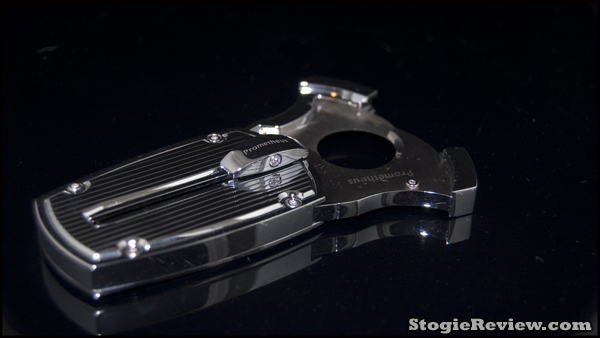
The specialty cutters category is a rather broad one. Not only does it include the occasional fancy cutter you may find at your local cigar shop, but I’m also going to lump in the cutters which are designed to be left on a table. The operation of these cutters is not going to vary much from what you are used to using, but they are items that you don’t necessarily see every day.
One example of a specialty cutter might include the Prometheus Cutter Y (pictured above). This item is a non-traditional double bladed guillotine, of sorts. Inside the handle are two retractable blades which are removed from the handle using a button. Once the blades are free of the handle, the cutter is gripped like any other double bladed guillotine.
What makes the Prometheus Cutter Y a specialty item, in my eyes, is its design. Unlike majority of the double bladed guillotine cutters you may find, this item is all metal and feels rather heavy in the hand. While some might toss this into a jacket pocket, I feel it is more suited to rest on your table, next to your polished Stinky Cigar Ashtray.
Another specialty cutter that you may come across is the Classic Boston Cigar Cutter. These cutters are rather pricey but some nicely adorned cigar lounges have them from time to time. Within the wooden enclosure of the Classic Boston Cigar Cutter is a V Cutter which utilizes a lever action.
Like you would expect by looking at this cutter, the head of your cigar is placed into the opening until it butts into the bottom of the cutout. Once the cigar is properly placed, grab a hold of the lever and pull the “V” shaped blade into the cap. The result, just like a hand-held V cutter, is a cigar with a V shaped notch to draw smoke through.
While these cutters may appear daunting at first, once they get used a time or two, you will find that there is nothing to worry about. In many cases they are just your standard cigar tool transformed into something more elegant.
General Advice
Before using any cutter, I generally recommend that you first moisten the cigar slightly. To do this, wet your lips and place the cigar in your mouth. Pull down on the foot of the cigar so this the cap rotates upward and drags across your upper lip. I find that this adds enough moisture to make the tobacco slightly pliable but prevents the head of the cigar from becoming soaked and slobbery.
While wetting the cap may make cutting your cigars a little easier, it is strongly suggested that you refrain from this practice when borrowing a cutter from a friend or using the community cutter at your local cigar shop.
Disclosure:
All cutters pictured in this article, with the exception of the Dewalt Compound Miter Saw (that bad boy is mine), were provided by our sponsor, Lighters Direct, specifically for this writeup on Selecting and Using Cigar Cutters. For pricing, and ordering information, please head on over to the Lighters Direct Website and take a look around.




That’s as complete as a guide about cutting cigars can get.
Great job Walt!
Great job Walt!
The only thing that could have made it better would be a short video if the DeWalt in action! LOL
Nice job Walt.
I’d like to see a small keychain version of the DeWalt, then you may be onto something.
You can call it “TheWalt”, lol
OK, OK, I’ll be quit know.
Nice job, Walt. That (IMO) sums up all of the useful products out there (note: useful…the cigar spike is not only stupid but also not useful). I tend to like a double bladed guillotine for my torpedo/shaped cigars and a punch for <46 ring gauges, but to each his own. When I get some money, that Prometheus Y will be mine…haha!
That’s the best cutter article I’ve read…thanks Walt. I tend to prefer a punch cut (where practical), but I have found that cut can sometimes promote nicotine build-up at the head. Of course when that happens, out comes the guillotine and “off with his head!”
Great article, it’s about time someone did it right.
Personally, I don’t moisten my cigars before cutting. I haven’t found it to be beneficial at all. To me, all it does is help pieces of the cap stick to the blades of the cutter. Also, I don’t find it very sanitary especially if your sharing cutters.
Very nice writeup! I also do not moisten the head of my cigar before cutting. I do however still tend to use a v-cut or punch most of the time. I have been trying to get away from them, but until I get a really nice cutter that will hold a sharp edge, the double blade I have is mostly relegated to torpedos/belicosas.
I want to also see the Dewalt cut that cigar 🙂
Mike
Great info.
Nice overview. I have never purchased an “expensive” cutter. I have several great single blade cutters that I’ve used for many years and never seem to dull. My trick is to place the cutter (single or double blade) on a flat surface (table, cigar box, etc.) and stand the cigar straight up. This provides a depth stop and takes just about the perfect amount of the cap off the first time. I cut 90% of my cigars this way every time. I have recently been given a double blade cutter with on side closed which accomplishes the same thing. Walt, we still need to meet up for a cigar one of these days!
One more kind: I bought a triple-bladed guillotine from Cuban Crafters and have basically been happy with it. The blades close in from three directions in a spiral motion, sort of like the “leaf” shutters on expensive cameras in the olden days. It takes all the advantages of a double-bladed a step further. Only drawback is a slightly increased “step effect”, as you discussed in this article due to three thicknesses of blades rather than two. Having said all that, I don’t use it much. I still find myself using my Xikar folding scissors 90% of the time and my V-cutter 9%. For pointed heads (e.g., belicosos or torpedos) I sometimes even make two V-cuts at right angles; seems to increase breathing surface without having to cut too far down from the tip.
Good summary article!
Nice job Walt. I’m a big fan of my Xikar multi-tool scissors and my Palio 2b Guillotine cutters. I would really like to find a nice medium priced V cutter, but as you said they seem to be non-existent.
mango
I really like this review. I’ve wondered how some of the other specialty cutters would work. I also enjoyed reading how others use, and don’t use, all these types of cutters.
You do realize the saw blade is on backwards right?
My bad, to much whiskey…the blade is right.
I need a cutter to cut my stoggies in half. This leave with 2 x 2.” smokes, just right. I welcome suggestions
I just recently wrote up an article on cutters as well, maybe not quite as comprehensive. Do you really think punches are less common a tool these days? It seems like everyone I know is trying to get me to use their damn punch…
I use a golf tee to punch a hole in my stogie on the links. Wet the tip of the cigar and carefully insert about a half-inch in and it works great every time and costs nothing!
Interesting….I was the same way, using my teeth or whatever instrument I had available at the time and never really getting the right satisfaction. It wasn’t until I bought myself an inexpensive V cutter did I come across zero problems. I find cheap ones are as good as the pricey ones, and it is definitely worth the affordable price to have one on hand if you love your cigars.